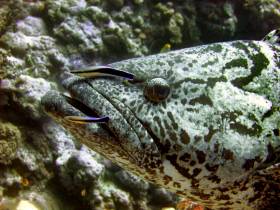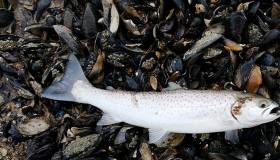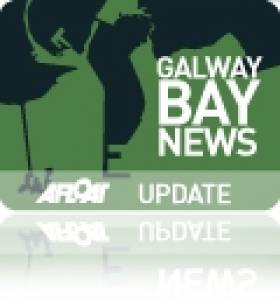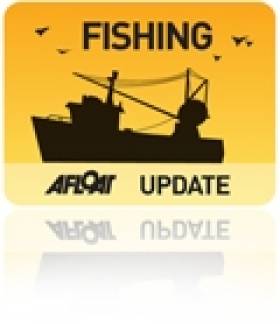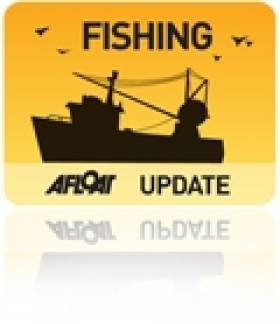Displaying items by tag: sea lice
Concerns Over Mass Use Of ‘Cleaner Fish’ In Irish Salmon Farms
Campaigners against salmon farms have raised concerns over the state of Irish wrasse stocks after it was confirmed the fish have been taken en masse to help clean lice from farmed salmon.
As Donegal News reports, a number of salmon farms in Donegal, Galway and other areas owned by Mowi — the former Marine Harvest — have between them moved in tonnes of wild wrasse, a known ‘cleaner fish’ that feeds on sea lice, over the past four years.
Responding to a Dáil debate question from Catherine Connolly TD this past summer, Marine Minister Michael Creed confirmed that “several special of cleaner fish are used in Ireland as a method of controlling sea lice”.
But there are fears that the mass withdrawal of wrasse and other such species from the wild could tip the balance of Ireland’s delicate marine ecosystem.
“The absence of wild wrasse in bays may result in stress and disease in other large species of fish which rely on wrasse to keep them clean of parasites,” said Billy Smyth, chair of Galway Bay Against Salmon Cages.
Donegal News has much more on the story HERE.
The Board of Inland Fisheries Ireland has welcomed new research by scientists from Inland Fisheries Ireland and Argyll Fisheries Trust (Scotland) which found that sea trout carry significantly higher levels of sea lice infestation closer to marine salmon farms. Researchers examined sea lice levels over 25 years from more than 20,000 sea trout. The sea trout were sampled from 94 separate river and lake systems in Ireland and Scotland at varying distances from salmon farms.
The research revealed that sea trout captured closer to salmon farms had significantly higher levels of lice infestation and were found to be of reduced weight. Sea trout are known to remain for extended periods in near-coastal waters where the majority of salmon farms are located. This fish is therefore particularly vulnerable to sea lice impact, having the potential to encounter lice of farm origin throughout much of its marine life.
The effect of the increased lice infestation was most evident in years of less rainfall, when a sea trout of average length (180mm) caught within 10 kilometres of a farm could weigh up to 10g less than fish of similar length caught more than 40 kilometres from a farm. The study covered the entire coasts of West Ireland and Scotland and accounted for variability in temperature and rainfall.
The research article entitled ‘Aquaculture and environmental drivers of salmon lice infestation and body condition in sea trout’ was authored by Dr. Samuel Shephard and Dr. Paddy Gargan of Inland Fisheries Ireland alongside Craig MacIntyre of the Argyll Fisheries Trust. It was published in the international journal Aquaculture Environment Interactions in October.
Studies have shown that the impact of sea lice in farmed areas on sea trout has been substantial with increased mortality, reduced body condition and a changed migratory behavior reported. Heavily liced sea trout return to freshwater prematurely to rid themselves of lice and exhibit very poor marine growth and greatly reduced marine survival. In fact, the most heavily lice infested sea trout die at sea. Rod catch data from 18 Connemara fisheries from 1974 to 2014 show a collapse in rod catch over the 1989/1990 period (see Figure 1). This collapse has been linked to lice infestation from salmon farms while recovery of sea trout rod catches to pre collapse levels has not occurred.
Sea trout offer significant angling value while traditionally the species was abundant on the west coast of Ireland. Angling is worth €836 million to the Irish economy every year and supports upwards of 11,000 jobs, often in rural and peripheral communities. Inland Fisheries Ireland carries out research across fish populations, their habitats and the ecosystem with a view to informing the protection and conservation of this precious resource.
Dr. Paddy Gargan, Senior Research Officer at Inland Fisheries Ireland and one of the report authors, said: “”While there had been some improvement in sea lice control in recent years, lice control on salmon farms was still not sufficient in certain west of Ireland bays during the spring migration period for sea trout to avoid heavy lice infestation and increased marine mortality. More effort is required to ensure lice levels on salmon farms are adequately controlled at this critical period when sea trout leave freshwater and enter the sea.”
Dr. Cathal Gallagher, Head of Research and Development at Inland Fisheries Ireland said: “The finding that salmon farming is responsible for increased sea lice infestation and for significantly reduced body condition in sea trout may have implications for current lice control management strategies. This research will inform coastal zone planning of aquaculture in the future and contribute towards the avoidance of potential impact on sea trout stocks.
Inland Fisheries Ireland is committed to protecting and conserving our fish populations and this research is crucial in managing the sea trout species in Ireland. This country is known as a unique angling destination as a result of its indigenous wild fish species and beautiful scenery. Continued investment in research is necessary to ensure the conservation and protection of our fisheries resource.”
Westport To Host Sea Lice Conference This September
#MarineScience - The 11th International Sea Lice Conference will be hosted by the Marine Institute in Westport, Co Mayo from 26-28 September 2016, it has been announced.
This biennial gathering of the world's most prominent sea lice research will hear the latest papers, presentations and posters of the most up-to-date research in the field – such as last year's paper that identified salmon farming's impact on wild salmon and sea trout stocks.
The goal of the conference is to bring together leading international researchers, groups and regulatory agencies to foster collaboration and communication on sea lice research and to advance our understanding of the key biological, environmental and management factors associated with sea lice in both wild and farmed settings.
Presenters will be invited to submit papers which may be published in the Journal of Fish Diseases as a special edition.
Registration is now open for prospective presenters, who should also submit abstracts of their research. A limited number of scholarships for students are also available.
For more information visit the conference website HERE.
Marine Institute Hits Back At Criticism Over Fish Farm Sea Lice Breaches
#SeaLice - Ireland was cited for 39 breaches of sea lice levels at fish farms in the first 10 months of this year.
And as The Irish Times reports, the figure is "more than double" that recorded in the whole of 2013.
That was the message from Don Staniford of the Global Alliance Against Industrial Aquaculture (GAAIA), an NGO that compiles data on fish farms across Europe.
But the Marine Institute has hit back, saying that levels were "low" during the spring migration period for wild salmon, the time when they are most at risk from sea lice.
The Irish Times has more on the story HERE.
Salmon Farms 'Can Have Significant Impact' On Wild Salmon and Sea Trout Stocks – IFI
#SeaLice - The chairman and board of Inland Fisheries Ireland (IFI) have welcomed a definitive review of over 300 scientific publications on the effects sea lice can have on sea trout stocks.
A team of top international scientists from Norway, Scotland and Ireland reviewed all available published studies on the effects of sea lice and have now concluded that sea lice have negatively impacted wild sea trout stocks in salmon farming areas in Ireland, Scotland and Norway.
Previously research was based on individually published studies, but this new review reached its conclusions based on comprehensive studies of the effects of salmon lice from over 300 scientific publications.
The project was funded by the Norwegian Seafood Research Fund, which provides investment in Norwegian seafood industry-based R&D with the objective of creating added value for the seafood industry.
The study also examined the potential effect of sea lice on salmon and concluded that sea lice have a potential significant and detrimental effect on marine survival of Atlantic salmon with potentially 12-44% fewer salmon spawning in salmon farming areas.
“These conclusions concur with previously published Inland Fisheries Ireland research on the potential impact of sea lice from marine salmon farms on salmon survival,” said IFI chairman Brendan O’Mahony.
The studies reviewed indicate that salmon farming increases the abundance of lice in marine habitats and that sea lice in intensively farmed areas have negatively impacted wild sea trout populations. The effects of sea lice on sea trout are increased marine mortality and reduced marine growth.
IFI says this new study confirms the evidence collected since the early 1990s in Ireland regarding the impact of sea lice on wild sea trout stocks, particularly in relation to the collapse of Connemara’s sea trout stocks.
The board of IFI reaffirmed that it has consistently called for marine salmon farms to maintain sea lice levels close to zero prior to and during the wild sea trout and salmon smolt migration period in spring.
IFI has also raised concerns regarding the location of salmon farms in the estuaries of salmon and sea trout rivers.
The IFI board says it believes this new review confirms the need for very tight regulation of sea lice levels on salmon farms and raises legitimate concerns with regard to the potential impact of new, large scale salmon farms, proposed along Ireland’s west coast, on salmon and sea trout stocks.
It's expected that regulators will now consider the results of this new review when making decisions on the sustainability and approval of future marine salmon aquaculture licences and the regulation of sea lice at existing sites, so as to ensure no negative impact on salmon and sea trout stocks.
#FishFarm - Bord Iascaigh Mhara (BIM) has responded to concerns from environmental groups that an ingredient in treatments for sea lice in salmon farms poses a threat to wild marine life.
As Galway Bay FM reports, campaigners Galway Bay Against Salmon Cages - one of the groups opposed to the planned Galway Bay fish farm - say that cypermethrin, an active ingredient in veterinary medicine used to treat sea lice, is toxic to aquatic organisms.
BIM aquaculture manager Donal Maguire attempted to play down fears over the use of the pesticide, saying it has been fully tested for toxicology in the marine environment.
However, another campaign group claims BIM's position is contrary to the manufacturer's own warnings on the use of the drug.
According to FishNews.eu, Friends of the Irish Environment (FIE) cited the Irish Medicines Board's product description for cypermethrin, which states that it is "dangerous to fish and other aquatic life" and demands that the chemical "should not be allowed to contaminate water".
FIE went on to describe cypermethrin as "a biocide which kills life, not a medicine that saves lives" and as "a highly active neurotoxin" with "known effects on fish and, most sensitive of all, crustaceans such as crabs and lobsters. Bathers and watersports [enthusiasts] may also be at risk."
Earlier this month, Inland Fisheries Ireland (IFI) expressed "serious concerns" over the findings of a study on wild salmon in Ireland that claimed fish farm schemes were less harmful to wild fish than pollution and possibly even beneficial to wild catchments.
IFI is among the significant opposition to BIM's proposed organic salmon farm off the Aran Islands, a 500-hectare project that would be the largest of its kind in Europe and create hundreds of jobs in the locality.
Protest in Galway Over Fish Farm Plans This Weekend
#Fishfarm - Galway Bay FM reports that a major protest is set to take place in Galway this weekend against the proposed deep sea fish farm off the Aran Islands.
Galway Bay Against Salmon Cages is organising the demonstration from Eyre Square on Saturday 2 March at noon in opposition to the 500-hectare organic salmon farm proposed by Bord Iascaigh Mhara (BIM).
The facility, to be located off Inis Oírr in Galway Bay, would be the largest of its kind in Europe and would double the State's production rate of organic salmon, cited by BIM as Ireland's leading organic food export.
However, the scheme has been facing strong opposition from fisheries groups and local anglers citing the potential environmental impact on wild salmon numbers and the threat to tourism in the area.
Inland Fisheries Ireland is among those bodies that have expressed concern over the fish farm plans, citing research on the effect of sea lice emanating from aquaculture facilities on the mortality rate of wild Atlantic salmon.
BIM responded to news of the protest by stating such action may be unnecessary due to the appeal mechanism available in the State's decision process.
IFI Welcomes New Research On Sea Lice and Wild Salmon
#FishFarm - Inland Fisheries Ireland has welcomed "a clear acceptance of the impact of sea lice on juvenile salmon" following a recent Marine Institute publication that identifies the effect of sea lice emanating from aquaculture facilities on wild Atlantic salmon mortality.
According to IFI, the paper published in the Journal of Fish Diseases "concurs with previously published international research" that it says establishes an incontrovertible link between fish farm developments and negative effects on local wild salmon numbers, as previously reported on Afloat.ie.
It adds that "the debate can now progress to identify the best methodologies to reduce or eliminate this impact" as well as moves on "the issue of escaped farmed salmon".
In a statement on the new paper, IFI says the research "identified that just under 40% of released juvenile salmon showed a significant difference in return rate between sea lice ‘treated’ and ‘non-treated’ groups, indicating that mortality from sea lice is significant in 40% of the releases in the study. Unfortunately, there was a significant effect from sea lice in six different bays along the west coast over the study period.
"This recent study provides further evidence that salmon will be impacted by sea lice. The location of salmon farms in relation to salmon rivers and the control of sea lice prior to and during juveniles salmon migration to their high seas feeding ground is critical if wild salmon stocks are not to be impacted.
"The development of resistance to chemical treatment of sea lice and other fish husbandry problems, such as pancreas disease and amoebic gill disease, are likely to make effective sea lice control even more difficult in future years."
IFI also highlights the Norwegian government's concerns about the impact of sea lice and escaped farm salmon on wild salmon stocks.
The statutory body for the protection and conservation for Ireland's inland fisheries reiterated its support for "the development of a sustainable aquaculture industry" to "safeguard wild salmon and sea trout stocks into the future".
It adds that recommendations on the above issues have been made in its submission to the Department of the Marine on the Environmental Impact Statement regarding the proposed deep-sea organic salmon farm in Galway Bay, a scheme that has been the subject of controversy over recent months.
High Levels of Sea Lice Detected at Irish Salmon Farms
#FishFarm - Two Irish fish farms were found to have consistently high levels of sea lice over the past six months, according to new figures.
Undercurrent News reports on findings by the Marine Institute which show that a farm owned by Marine Harvest Ireland at Lough Swilly and one operated by the Mannin Bay Salmon Company in Corhounagh were "found to have levels of sea lice which exceed the Marine Institute's protocol level of two pregnant female lice per fish."
Sea lice levels at the Lough Swilly site in particular climbed from an average of 4.35 per fish to a high of 71.72 in September before dropping to a still-high 44.88 last month.
A statement issued by Marine Harvest played down concerns over the new figures, noting that "treatment trigger levels are set a low level" in Ireland compared to other countries, and that it uses "tried and tested procedures" to deal with such infestations.
It added that lice numbers can rise and fall in tandem with changes in climate, as experienced in the latter months of 2012.
As reported on Afloat.ie last month, a new international study says some 39% of salmon mortalities can be attributed to the impact of sea lice - predominantly from fish farms - on wild salmon fisheries.
In a press release, Don Staniford of lobby group the Global Alliance Against Industrial Aquaculture (GAAIA) said: “The Irish Government should be controlling sea lice infestation on salmon farms not promoting even bigger feedlots such as the proposed 15,000-metric-ton farm in Galway Bay.”
Undercurrent News has more on the story HERE.
BIM to Hold Public Tender for Galway Bay Fish Farm
#FISHFARM - Bord Iascaigh Mhara (BIM) is set to hold a public tender process for the development of the proposed deep sea fish farm in Galway Bay, according to The Irish Times.
Financiers around the world have expressed interest in the 500-hectare organic salmon farm to be located off Inis Oirr in the Aran Islands, though BIM said it was not at liberty to disclose who they are.
As previously reported on Afloat.ie, the proposed fish farm would be the largest of its kind in Europe, set to double the State's production of organic salmon.
BIM says it is already receiving inquiries for jobs from emigrants wishing to return home.
However the scheme has faced opposition from Inland Fisheries Ireland (IFI) and local anglers, who cite the potential threat to wild salmon numbers in the area.
IFI recently issued a statement regarding its submission on the project's Environmental Impact Statement, raising concerns about the scale of the development and the impact of sea lice - infestations of which are often concentrated by aquaculture.
The public consultation that began in mid-October is scheduled to conclude next Wednesday 12 December.


























